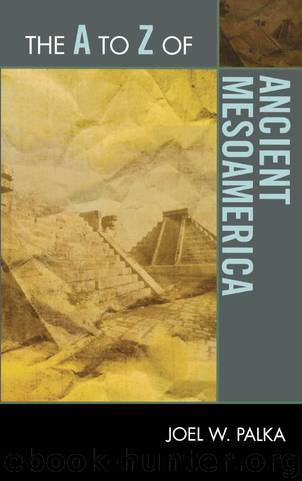The A to Z of Ancient Mesoamerica by Joel W. Palka

Author:Joel W. Palka
Language: eng
Format: epub
Publisher: Scarecrow Press
Published: 2000-04-08T04:00:00+00:00
P
PALENQUE. Palenque is one of the most beautiful and architecturally spectacular of the Classic Maya sites in the southern lowlands. Palenque is located near the foothills of the Chiapas highlands and near the Usumacinta River, and is one of the furthermost western Maya sites. This site is well known for its elegant architecture, sculpted wall panels in its temples, long and beautifully executed hieroglyphic texts, and royal tombs. The name Palenque denotes “fenced-in (place)” in Spanish and was probably given to this area or site during late colonial times, because of the presence of palisaded Maya villages in this region. An ancient place name for this area and for the site is Lakam ha, which may refer to the pools of water at the site or one of the large rivers nearby. Palenque was one of the first sites discovered and frequently visited by outsiders and explorers in the mid-19th century.
Much archaeological research has been conducted at Palenque, and many of the site’s stone masonry buildings have been excavated and restored. The palace area that is set upon an artificial platform contains long range-type structures with vaulted roofs, roof combs (vertical ornamentation placed over the top center of the roof), eroded mural paintings, interior courtyards, aqueducts, exterior stucco facades depicting nobles, and stone sculpture. A unique four-story tower with windows facing the cardinal directions on each floor is part of this architectural complex. Stone thrones with hieroglyphic texts and stone carvings depicting war captives are found in the palace group.
One of the most impressive constructions at Palenque, the Temple of the Inscriptions, is located near the center of the site and main plaza and is built into a natural hill. This structure is a nine-terraced funerary monument that exhibits a central stairway and a large temple superstructure with multiple entrances between columns and monolithic wall panels with finely carved hieroglyphic writing. These texts, among others, have the Palenque emblem glyph, which is a depiction of a bone (Bak’).
While the Temple of Inscriptions was being excavated in the early 1950s, a descending staircase from the temple superstructure into the core of the building was cleared and a fabulously rich royal tomb was discovered. This large tomb has a vaulted roof, walls adorned with stucco figures of Maya elite personages, and a stone sarcophagus that has an elaborately carved limestone slab for a lid. The sarcophagus contains the skeleton of an elderly male who wore a mosaic jade, shell, and obsidian mask and a large quantity of worked jade jewelry. The inscriptions on the sarcophagus lid and in the temple superstructure identify the tomb as that of “K’inich Hanab” Pacal, who was one of the greatest of the Palenque kings. Pacal was responsible for the creation of much of the architecture and artwork at the site, which were made during his reign.
The Temples of the Sun, the Cross, and the Foliated Cross are monumental buildings found to the north of the Temple of Inscriptions. This series of temples was built and dedicated by King Pacal’s son, “Chan Bahlum.
Download
This site does not store any files on its server. We only index and link to content provided by other sites. Please contact the content providers to delete copyright contents if any and email us, we'll remove relevant links or contents immediately.
A Dictionary of Sociology by Unknown(3027)
The Art of Dramatic Writing: Its Basis in the Creative Interpretation of Human Motives by Egri Lajos(3015)
The Dictionary of Body Language by Joe Navarro(2946)
0041152001443424520 .pdf by Unknown(2784)
How The Mind Works by Steven Pinker(2729)
Day by Elie Wiesel(2717)
Merriam-Webster's Collegiate Thesaurus, Second Edition by Merriam-Webster Inc(2710)
The Meaning of the Library by unknow(2504)
The Official Guide to the TOEFL Test by ETS(2286)
A History of Warfare by John Keegan(2185)
The Emotion Thesaurus: A Writer's Guide to Character Expression by Puglisi Becca & Ackerman Angela(2122)
Emotion Amplifiers by Angela Ackerman & Becca Puglisi(2008)
MASTER LISTS FOR WRITERS: Thesauruses, Plots, Character Traits, Names, and More by Bryn Donovan(1907)
The Cambridge Guide to English Usage by PAM PETERS(1880)
Merriam-Webster's Pocket Dictionary by Merriam-Webster(1880)
Star Wars The Rise of Skywalker The Visual Dictionary by Pablo Hidalgo(1844)
Lucky Jim by Kingsley Amis(1697)
American Accent Training by Ann Cook(1636)
Word by Word by Kory Stamper(1614)
